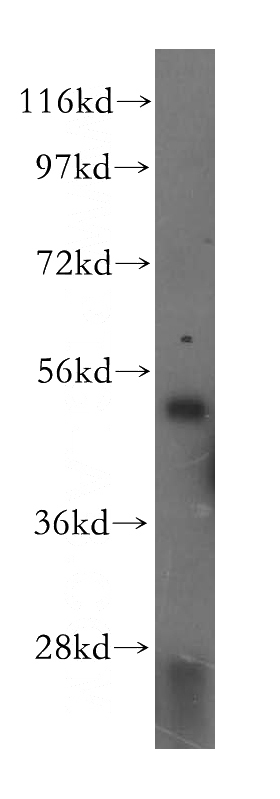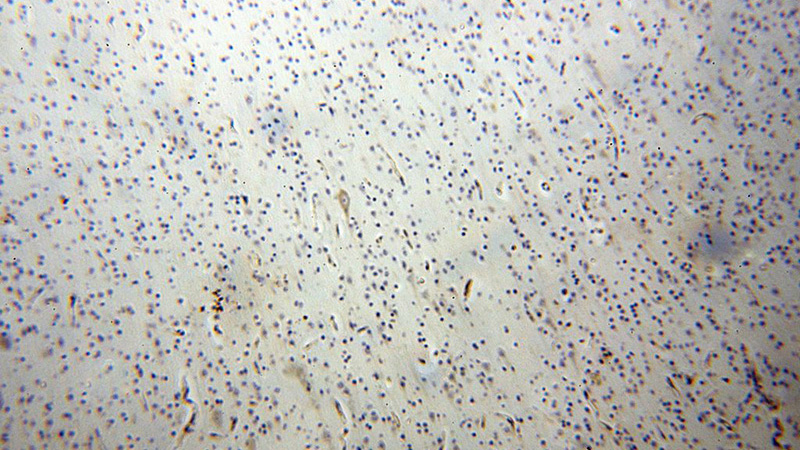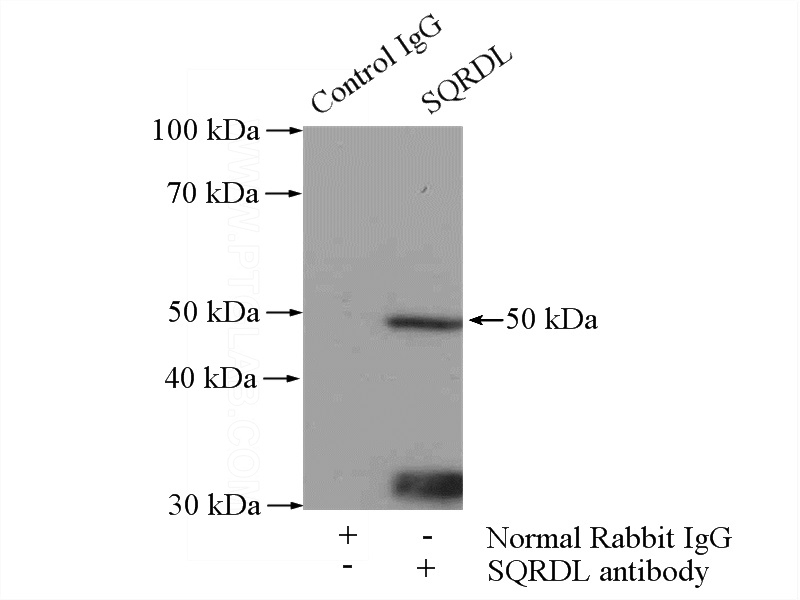-
Product Name
SQRDL antibody
- Documents
-
Description
SQRDL Rabbit Polyclonal antibody. Positive IHC detected in human brain tissue, human lung tissue, human spleen tissue, human testis tissue. Positive IP detected in HeLa cells. Positive WB detected in HepG2 cells, HeLa cells. Observed molecular weight by Western-blot: 50kd
-
Tested applications
ELISA, WB, IHC, IP
-
Species reactivity
Human,Mouse,Rat; other species not tested.
-
Alternative names
CGI 44 antibody; SQRDL antibody
-
Isotype
Rabbit IgG
-
Preparation
This antibody was obtained by immunization of SQRDL recombinant protein (Accession Number: NM_021199). Purification method: Antigen affinity purified.
-
Clonality
Polyclonal
-
Formulation
PBS with 0.02% sodium azide and 50% glycerol pH 7.3.
-
Storage instructions
Store at -20℃. DO NOT ALIQUOT
-
Applications
Recommended Dilution:
WB: 1:500-1:5000
IP: 1:200-1:2000
IHC: 1:20-1:200
-
Validations

HepG2 cells were subjected to SDS PAGE followed by western blot with Catalog No:115659(SQRDL antibody) at dilution of 1:500

Immunohistochemical of paraffin-embedded human brain using Catalog No:115659(SQRDL antibody) at dilution of 1:100 (under 10x lens)

Immunohistochemical of paraffin-embedded human brain using Catalog No:115659(SQRDL antibody) at dilution of 1:100 (under 40x lens)

IP Result of anti-SQRDL (IP:Catalog No:115659, 4ug; Detection:Catalog No:115659 1:500) with HeLa cells lysate 2000ug.
-
Background
SQRDL(Sulfide:quinone oxidoreductase, mitochondrial) catalyzes the oxidation of hydrogen sulfide, with the help of a quinone.Although the SQRDL precursor protein displays a molecular weight of 50 kDa,a prominent band at about 46 kDa is detected by western blot. This discrepancy reflects the cleavage of an N-terminal targeting sequence of 4 kDa during the import of the protein into the mitochondria(PMID:22067608).SQRDL is one of the enzymes involved in H2S signaling in a discrete population of neurons, oligodendrocytes, and endothelial cells.
-
References
- Hine C, Harputlugil E, Zhang Y. Endogenous hydrogen sulfide production is essential for dietary restriction benefits. Cell. 160(1-2):132-44. 2015.
- Linden DR, Furne J, Stoltz GJ, Abdel-Rehim MS, Levitt MD, Szurszewski JH. Sulphide quinone reductase contributes to hydrogen sulphide metabolism in murine peripheral tissues but not in the CNS. British journal of pharmacology. 165(7):2178-90. 2012.
- Módis K, Coletta C, Erdélyi K, Papapetropoulos A, Szabo C. Intramitochondrial hydrogen sulfide production by 3-mercaptopyruvate sulfurtransferase maintains mitochondrial electron flow and supports cellular bioenergetics. FASEB journal : official publication of the Federation of American Societies for Experimental Biology. 27(2):601-11. 2013.
- Roman HB, Hirschberger LL, Krijt J, Valli A, Kožich V, Stipanuk MH. The cysteine dioxgenase knockout mouse: altered cysteine metabolism in nonhepatic tissues leads to excess H2S/HS(-) production and evidence of pancreatic and lung toxicity. Antioxidants & redox signaling. 19(12):1321-36. 2013.
- Flannigan KL, Ferraz JG, Wang R, Wallace JL. Enhanced synthesis and diminished degradation of hydrogen sulfide in experimental colitis: a site-specific, pro-resolution mechanism. PloS one. 8(8):e71962. 2013.
- Szabo C, Ransy C, Módis K. Regulation of mitochondrial bioenergetic function by hydrogen sulfide. Part I. Biochemical and physiological mechanisms. British journal of pharmacology. 171(8):2099-122. 2014.
- Jurkowska H, Roman HB, Hirschberger LL. Primary hepatocytes from mice lacking cysteine dioxygenase show increased cysteine concentrations and higher rates of metabolism of cysteine to hydrogen sulfide and thiosulfate. Amino acids. 46(5):1353-65. 2014.
Related Products / Services
Please note: All products are "FOR RESEARCH USE ONLY AND ARE NOT INTENDED FOR DIAGNOSTIC OR THERAPEUTIC USE"
